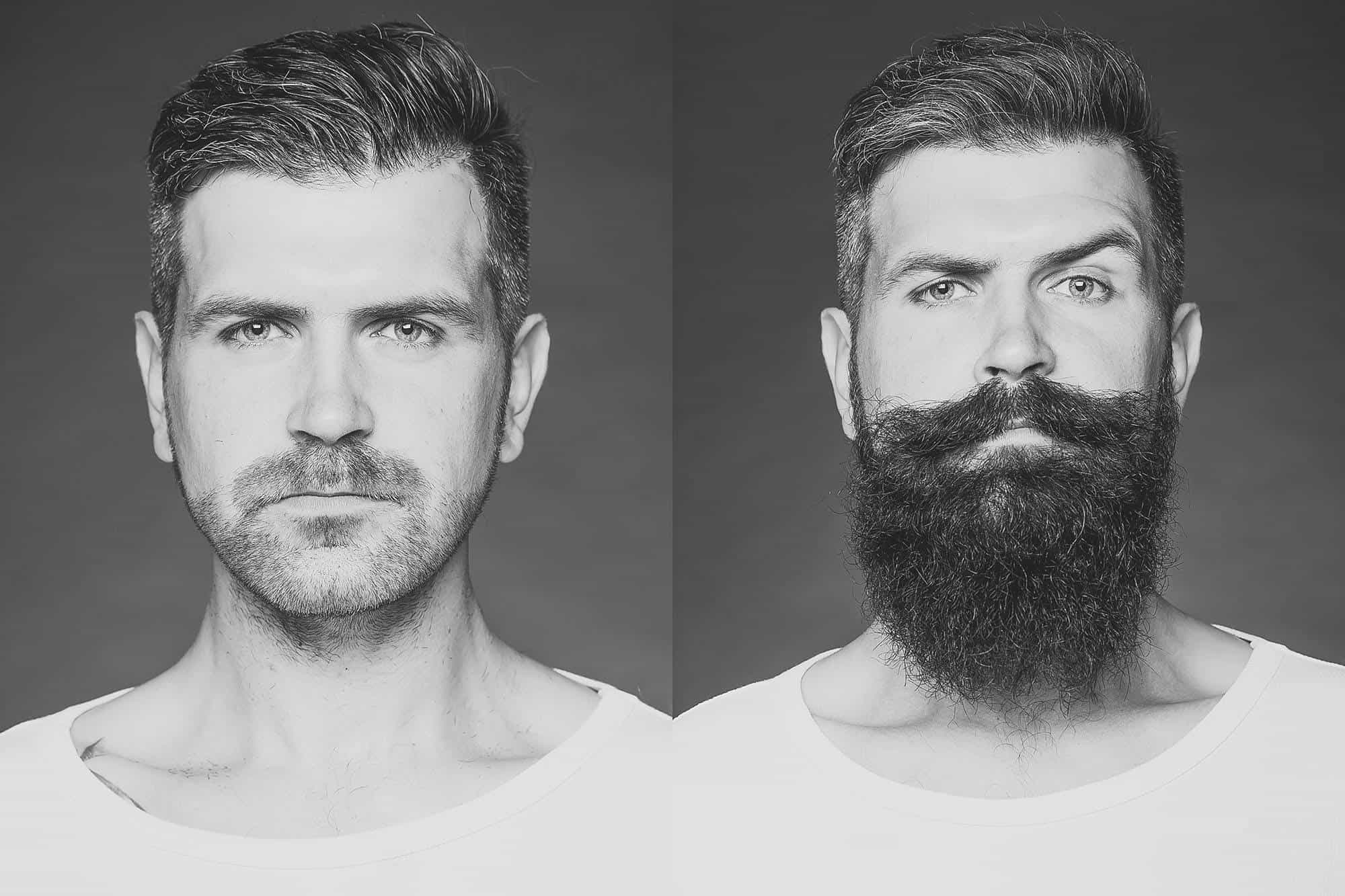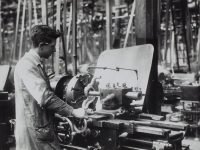Not everyone can pull off every beard style. Everybody grows facial hair differently, so make sure that you can safely rock the type of beard that you choose.
[lwptoc skipHeadingLevel=”h1,h3,h4,h5,h6″]
They say the state of a person’s beard reflects his personality. Growing facial hair has never been out of fashion, although we see a resurgence of beards, especially long beard styles in the past few years.
One of the easiest appearances to maintain is a full beard. Some men experience more trouble growing a beard than others. The full beard is a popular style of many men. Patience is the key to success when you are trying to grow this type of beard style.
You will need to keep your beard trimmed in order to keep it neat and clean. The first thing you need to do is stop shaving for at least three weeks.
The following are a few general types of natural facial hair seen in men:
1. Full Beard
This one is natural-looking and complete — the only one that can really pull everything off. You have the base of hair and could easily pull off anything from a full beard to a mustache to a chin strap beard. There is nothing standing in your way, and the playing field for you is wide open.
2. Amish Beard
Back to the early days of the Amish when sporting elaborate mustaches were common among those in the military. It isn’t until an Amish man gets married that he will cease shaving his Amish beard and allow it to grow out, with beards being a mark of an Amish male having become a man.
3. Balbo Beard
A Balbo beard is a beard without sideburns and a trimmed, floating mustache and looks almost similar to the short boxed beard. The Balbo beard is ideal for those with round face shapes.
4. Ducktail Beard
The Ducktail style of beard is another twist of the original full beard and gets its name from its appearance. To create a ducktail beard, the upper part is trimmed shorter while the hair on the chin area is allowed to grow as long as the man wants it to grow, giving that perfect mix of ruggedness in style.
5. Mutton Chops
Also known as sideburns, the hair stretches into a mustache down the cheeks, except the chin. The mutton chops beard were fashionable throughout the mid-19th century and represented intellect and masculinity.
6. Goatee
A goatee beard is a style of facial hair incorporating hair on one’s chin but not on one’s cheeks. The exact nature of the goatee beard has varied according to time and culture.
7. Stubble Beard
This type of facial hair tends to grow fast days after shaving, low-maintenance, and stylish, giving the stubble beard look. Considered a great beard style for face shape. Stubble can also add maturity to a youthful face.
Some men didn’t get the beard gene and you could easily count the number of hairs on your face without going into triple digits.
Unfortunately, you should just rock the clean-shaved look. If you can’t grow a good base to do something with, then just don’t try.
A lot of teenagers are like this and they usually grow out of it. However, some people never do. A lot of the time, people with bad acne scars might have a lot of damaged hair follicles on their faces and thus won’t be able to grow very good beards.
If you don’t know which type of facial hair grower you are, stop shaving for a week and see what happens. This is really the best way to help present your options on your facial hairstyles.
Growing A Beard

Some men take longer to grow their hair. Your beard should not have patchy areas. When your beard begins to mature, you need to start shaping it. Some hair will grow quicker in some areas and cause your beard to grow unevenly. Trim your beard so it is even throughout. Use an electric shaver to remove hair that has become stays. Stray hairs make you appear unprofessional and rough.
More men are now looking for tips on how to maintain their beards given the busy lives that they lead. Read on if you want to learn how to maintain a beard the right way.
On how to grow a proper beard, the time that it takes to grow a beard depends on the person’s sprouting level. The first few weeks could be a bit awkward and unseemly.
Co-workers might think you are just too lazy to shave. In order to make it clear that you intend to grow and maintain a proper beard, remove the hairs that grow on the “neckbeard” area with a fresh blade or high-performance trimmer.
To help you deal with the itch, immature whiskers can be softened with products labeled “beard wash.”
The Most Common Beard Styles

Ever since the invention of the razor several hundred years ago, man could express himself through the art of facial hairstyles. Some people go without a beard or any type of facial hair for a number of reasons.
Maybe you can’t grow facial hair very well. Maybe you have to be clean-shaven for work at all times. Maybe you just can’t find a style that works well for you. Regardless, there are still plenty of men who like to show off their beard style.
Facial hair is something that defines men. Women can never really take this away from us. We are the only ones that are capable of growing a good amount of facial hair, and we are the only ones that will look good sporting it.
Some styles look a little better than others. Let’s go over the common types of facial hair, from the least amount of hair to the most amount.
Clean-shaven
This is for the men who either can’t grow much facial hair, don’t like the look, don’t like the feel, or simply look like a goof sporting any sort of style. It is pretty simple to maintain but requires daily full shaves.
Mustache
Just a strip of hair on the upper lip. This style has been slowly going out of style, and younger men are sporting the mustache less and less as the trend is slowing down. There are some awkward stages in trying to grow the mustache, but once you have it going it looks pretty normal. You still need to shave every day; there is just a little less area to shave.
Goatee
This is basically a mustache that goes down and around the mouth. Your cheeks are still clean-shaven, but you leave the spot around your mouth still grown out. This style looks good on some men but just terrible on others.
You really need to have the ability to grow some good upper-lip hair to pull this off. Again, daily shaving is still needed but even less surface to shave than the mustache.
Neard
It stands for Neck-Beard. You shave everything except for your neck. This is only done when people are trying to look like a goof.
Chin strap
This is basically a strip that goes down your jawline and connects at your chin. Some men have found it is difficult to keep the strip even without taking too much off.
The 5 o’clock shadow
This is preferred by some men and their personal favorite. Just do a clean shave every other day. Or every three days. Others, however, go 5 days.
The Jesus Beard
Simply don’t shave, ever. If you want bum status, don’t cut your hair or shower either. The only time this style acceptable is if you are getting ready for a role in a movie or Halloween.
Regardless of your typical style, be sure to experiment and enjoy your facial hair.
99% of the time, facial hair is aging. This is primarily because we simply associate facial hair with age. But it is also because even before you start to see gray hair on your head, you will begin to see gray hair on your face. If you have a full beard, cut it down to (at the most) a trim goatee and mustache. If you have a goatee, go clean-shaven. This is likely to take years off of your appearance.
Source:medlineplus.gov
Why Some Men Can’t Grow A Beard
Men of all ages wonder why they can’t grow facial hair. Often this is a question asked by young men in their teens who feel anxious because their peers seem to be able to grow full beards whereas they can barely cultivate a few sparse tufts. However, the question is also frequently asked by older men who feel a little insecure about their “baby-face” features that have remained well into adulthood.
Men who have difficulty growing a beard invariably want to know whether something is wrong with them and whether their lack of hair is related to some more serious medical condition.
Only a GP can advise whether there is a more serious medical condition lurking in the wings, but the single most common reason that men can’t grow facial hair is simply because of their individual genetic characteristics.
Teenage boys should always be patient before worrying about their facial baldness. Genetic particularities determine when each individual goes through puberty, which hair traits they will exhibit, and the time in which facial hair characteristics will develop.
Some boys will develop dense hair from only 13 or 14 years of age whereas others won’t start to see signs of growth until the late teens and, in rare cases, the early 20s. The important point for teenagers, therefore, is to take a ‘wait-and-see’ attitude before desperately asking why they can’t grow facial hair.
However, for men in their mid to late 20s and onwards who developed normally through puberty but still can’t grow facial hair, a wait-and-see approach will clearly no longer be appropriate. In the vast majority of cases, the reason that older men can’t grow a beard is down to genetics.
Beard And Genetics
Each person has a different genetic code that determines every characteristic of hair and eye color to natural strength and size.
Genetics is also responsible for dictating whether a man will or won’t be able to grow facial hair. It is however important to note that in a small number of cases, men may be suffering from conditions such as hormonal imbalances which may only be identified and rectified by medical professionals.
Once genetics has been identified as the reason why a man can’t grow facial hair, the question is what can be done. A person’s genetic makeup cannot itself be changed but there may be ways in which facial hair can be artificially stimulated.
How To Trim A Beard
You might be the kind of person who would rather leave the beard trimming activities to professionals. This is actually the best approach. You can get your hands on trimmers and scissors, but if you have any doubts at all about your ability to trim the beard properly, and then do not even attempt it. It does not subtract from your manliness.
However, if you insist on a DIY approach on how to trim a beard, then start by purchasing the right tools. Do not settle for anything less than a pair of professional barber’s scissors. If you would rather use a beard trimmer, find a cordless and rechargeable unit.
A wide-toothed comb for the beard and a fine-toothed mustache comb must also be on your list of items to purchase. To complete the list, you can add a three-way mirror and a magnifying mirror.
Proper trimming with a comb or beard brush that you comb through the hair strands and cut only on the outside of the comb. If you are doing it for the first time, take the precaution of cutting just enough.
Shaping A Beard

The best way to come upon how to shape a beard with an asymmetrical appearance after a do-it-yourself trim is to start from the ears working down toward the chin. If you have a mustache, work on the mustache first, combing it downward. A mustache must be trimmed from the middle moving laterally toward the side of the mouth.
With a beard trimmer, you usually get a trimming guide that is removable and adjustable. This approach is quite helpful so that you end up with an even trim. You may set it to the length that you desire and it will keep to this measurement.
If the beard has reached the desired length already, the trimmer is the preferred tool over a pair of scissors. When you trim, make sure that the beard’s neckline is clearly defined.
Professional beard trimmers do not trim when the hair is still wet since wet hair has a longer length than dry hair. You do not want to end up with a beard that is trimmed too close so do not work on a wet beard.



